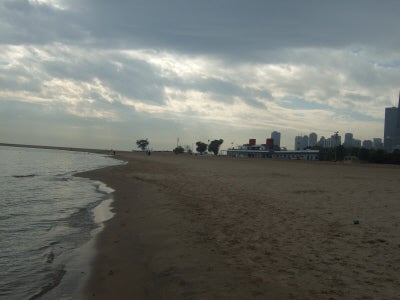The Third Rail and Michael Harvey's Chicago
Michael Harvey’s Chicago is not just a city, it’s a criminal playground; full of mystery and intrigue. Our hero, private investigator Michael Kelly, can hardly leave his apartment without running into a new murder or cover-up, and each crime is indelibly linked to its location. Harvey sees Chicago as a crime city like no other, in part because of its aggressive political nature:
“If you ever watched the Chicago Bears, you know all there is to be learned about the city. The Bears play smash-mouth football, with an emphasis on smash. [ . . . ] Chicago plays by its own rules and keeps its own score. Chicago is going to inflict its pain, take its pound of flesh, and tell you about it all day. If you substitute politicians and politics for ‘da Bears’ and football, you’ll have an idea of how the power brokers in this city operate.”
This is a city of power and aggression, but also a city of great beauty, fun, and accessibility. From the looming tracks of the L train to the marble steps of City Hall, whether sipping the java from Intelligentsia or throwing back a Bud at the Billy Goat Tavern, Chicago is well-covered in Harvey’s research. Whether you’re a native of Chi-town, or visiting for the first time, there are many paths you can take to experience the city through Harvey’s eyes.
The Third Rail, the latest installment in Kelly’s adventures, sets the city’s transit system as a means to murder. The elevated train—known as the L—serves as the scene of the crime as a woman is shot while waiting for her ride to work. Kelly is thrown into the midst of this chaos when he learns of a connection between the spreading violence in the city and an event in his own shadowed past. When his girlfriend, Judge Rachel Swenson, becomes a target, Kelly must take action and confront the killers himself.
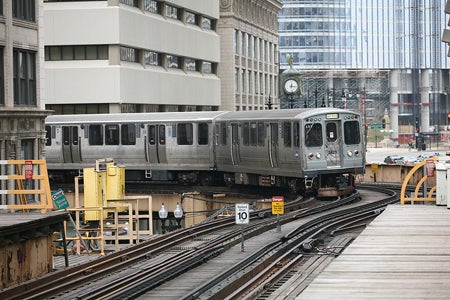
Harvey took inspiration for the third book’s central mystery from the 1977 Chicago Loop derailment, in which four cars fell off the elevated platform, resulting in the death of 11 people. Watching the trains as they run above the streets of the city, the tracks cast long shadows over the citizens below, suggesting an eerie world of future crimes and escapades. You shouldn’t be afraid to ride the rails when you visit the city—it’s one of the best maintained transit systems in the country, and hasn’t had a major accident since 1977—but it’s easy to spot where Harvey saw the potential setting for a terrific thriller.
The Third Rail also takes the reader to several sites central to Chicago’s Greek-American population: namely, Holy Name Cathedral, where Kelly expresses ambivalence for the Catholic hierarcy, and Greektown, which Kelly calls a “home away from home for out-of-town businessmen looking for a shot of ouzo, a leg of lamb, or a wayward belly dancer” and where Kelly finds Mayor John Wilson right about to bite into a helping of saganaki. It isn’t long before Kelly’s leads in the case take him to Bucktown, a neighborhood he says “got its name from the goats Polish immigrants used to tie up in their front yards. Today the goats are gone, replaced by angst-ridden hipsters, spiked goths, and dewy-eyed emos.”
Harvey manages to weave a lot of endorsements into his novels, but they clearly serve as payment for the work they enabled; many of Kelly’s regular haunts are the places Harvey goes to work, cafes and bars that provide great inspiration for his writing, and a place for Kelly to nurse his theories and wounds over a beer or a cup of joe. Harvey has mentioned his fondness for Intelligentsia, the local coffee shop on Broadway where he goes to work, and where Kelly drinks “the best joe in the city,” and also where he meets with his good friend Nicole over the course of the first novel, The Chicago Way:
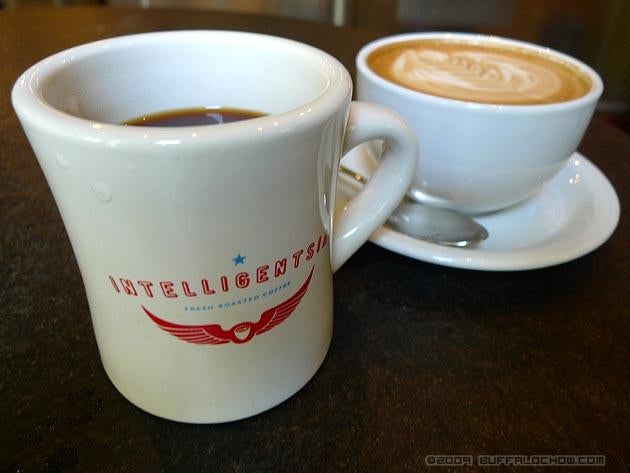
Typical Intelligentsia crowd. Up front, a couple of old men drinking large coffees, doing the neighborhood gossip with Gemma, a pink-haired barista and queen of the double-shot macchiato. In the back, a table of DePaul students huddled for warmth around major skim lattes and tapped away on their PowerBooks. In between, a smattering of NPR types, downing double shots of espresso and talking aloud to anyone who would listen about how much they hated George W. Bush.
But Kelly’s prefers brews over baristas; his real favorites are the wood-paneled bars and dive diners, from The Hidden Shamrock (where Kelly nurses a Guinness “with a froth slick and sweet as morning cream”) to The Billy Goat Tavern, “more cave than tavern” and inspiration for the famous Olympia Diner sketch from Saturday Night Live, and where Kelly and his Tribune source Fred Jacobs order up double cheeseburgers and beers, “rolling out the history of their city. Pushing at the past, pulling it into the present. Arguing and exaggerating. Preserving what’s been and making it come to life again. All for the price of a drink and available seven days a week, in the home of the Goat.” But Harvey always brings it back to the character of the customer, as in his description of the Chicago Institution Mr. Beef, which, Kelly notes, “to the untrained eye, it might seem like just another sandwich joint. Inside, however, is an entirely different matter. Inside, in fact, is an entirely different state of mind.
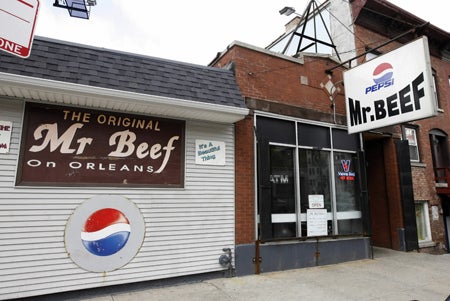
To the left is the counter, peopled by three or four workers, yelling at one another in a variety of languages. On the other side of the counter are the customers, various and sundry specimens of Midwestern Man, stuffed and on display. Specimen #1: Large belly hanging over frayed leather belt, Wrangler jeans, Red Wing work boots, and a key ring dangling on the side. Specimen #2: Large belly hanging over fake leather belt, Men’s Warehouse suit, cracked Florsheim shoes, and a cell phone clipped on the side. Specimen #3: Large belly hanging over money belt, Tommy Bahama silk pants, Cole Haan slip-ons, and a racing form stuffed in a side pocket. [ . . . ] Each day any and all forms of Midwestern Man line up, single file, amid pictures of Leno, Letterman, Sinatra, and, of course, Da Coach. Midwestern Man, however, ignores all the pretty faces on the wall. He is here to pay homage to the true star of the show: Da Beef.
It is sliced thin off a roasting skewer and slid into a soft Italian roll. The beef is ordered dipped or not, with hot, sweet, or both. Dipped means the entire sandwich is dipped in its own juices before being wrapped up in white paper and shoved across the counter. Hot and sweet refers to peppers, usually. Order a hot, sweet beef, dipped—you get it with the works. You also get some of the crudest sexual comments known to man as the sandwich is being prepared. They come from the regulars, avera
ge age 107. They sit like the peanut gallery they are, stacked on stools along the front window, all day, every day. They sip coffee and talk about sex they haven’t had since Christ was a carpenter. Nice guys, funny guys. A lot of fake hair, a lot of chains, a lot of grabbing themselves. There are worse things to be doing when you are 107. Like being dead.
As you can see, reading Harvey writing Chicago is as juicy an experience as digging into Da Beef straight out of its white paper wrapping.
As Harvey said in his opening, this is a city preoccupied with power and its origins; Kelly stops in at multiple high-prestige locations in the city, looking into important room reservations at The Drake Hotel, tracking cabs taking the wealthy home to turn-of-the century mansions on Hudson Avenue, and the aspirational colonials housing the up-and-comers of the city in Sauganash. But nowhere is Harvey’s writing more perceptive of power than in the permanent residence of the city’s political forces. In his second book, The Fifth Floor, Kelly attempts to uncover a massive conspiracy surrounding the Great Chicago Fire, one of the most tragic events in the city’s history. In seeking out those who might obfuscate the true nature of the crime, Harvey stops in, naturally, at the lauded steps of City Hall, the source of the infamous fifth floor. That floor houses the Office of the Mayor, or “the Man on Five” as he’s known to those that carry out his whims. Nowadays City Hall can be notably less ominous, especially since the installation of a rooftop garden containing 20,000 plants, part of Mayor Daley’s plan to make Chicago the “greenest city in America.” But when Kelly visits City Hall, the only green he senses is the presence of cold hard cash:
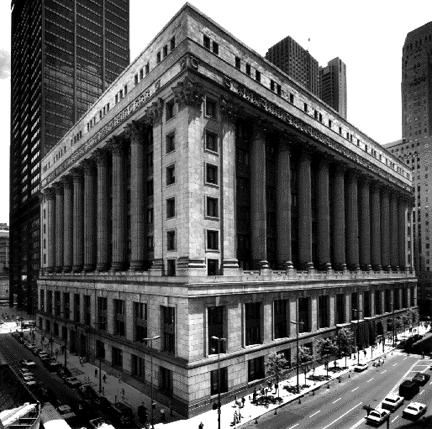
The fifth floor of City Hall looked a lot like the fourth and even more like the sixth. The difference lingered in the shadows. There you could catch a glimpse of ambition, the faintest whiff of avarice, and the footsteps of those who curried favor. Sometimes lost, sometimes won, but always curried. Because that’s what the Fifth Floor was all about. A court of intrigue, inside a building of stone and a city of red blood and muscle. At its center sat the only door along the entire hallway that mattered. A plain and simple door. Brown and wooden. [ . . . ] Just simple letters, gold leaf, five in all, hammered into the wood with tenpenny nails. Five letters that spelled mayor. Anyone who needed any more of an introduction to this door need not bother stepping through its crooked portal.
But perhaps my favorite spot in Harvey’s riveting is a spot of great tranquility: late in The Chicago Way, Harvey takes a long walk along the waterfront by North Avenue Beach, having just wrapped up a major mystery that affected him deeply:
Two months hence, summer would be in the offing. Early morning joggers and yoga in the sand, the city standing tall on one side, nothing but blue water on the other. The quiet cry of a seagull overhead and the small talk of Gold Coast locals, walking their dogs along the footpaths and getting their coffee before the day heated up. [ . . . ] Music floating out over the water, eclectic strands mixing and mingling into a harmonious whole. The lazy smell of suntan oil, treadmills grinding out miles at the outdoor gym, beer and brats cooking at the beach house. People lying out on their blankets, reading paperbacks, talking, sizzling under the sun, and, of course, flirting. In the early afternoon [ . . . ] young professionals would descend from their high-rises and climb out of the Loop, looking for some beach volleyball. Running, jumping, sweating, more bare skin, more suntan oil, more beer, and, of course, more flirting.
As the sun dipped behind the city’s skyline, North Avenue Beach would grow quiet again. [ . . . ] Night would creep up and over the lake, draining it of color and leaving a vast black emptiness at the edge of the city. Nothing visible, nothing tangible, except the sound of tomorrow, knocking gently against the breakwater.
Those were the thoughts that kept me warm as I walked along the beach. A pigeon loitered nearby, caring not a whit for my musings and keeping an eye on the doughnut I’d gotten to go along with my coffee. I took a bite and threw it at the black-eyed beast, who pecked it into pieces and made off with as much as he could carry. I took the lid off the coffee and breathed in the heat, thinking it might warm me up. All it did was make my coffee cold.
Harvey knows this city in his bones, and it’s clear in every glorious word of these three terrific novels. Take a trip to Harvey’s Chicago, and get your hands on his books today.
Buy the book: Amazon | Barnes & Noble| Borders | Random House
Check out this map to take you to all of Harvey’s haunts!
View Michael Harvey’s Chicago in a larger map
